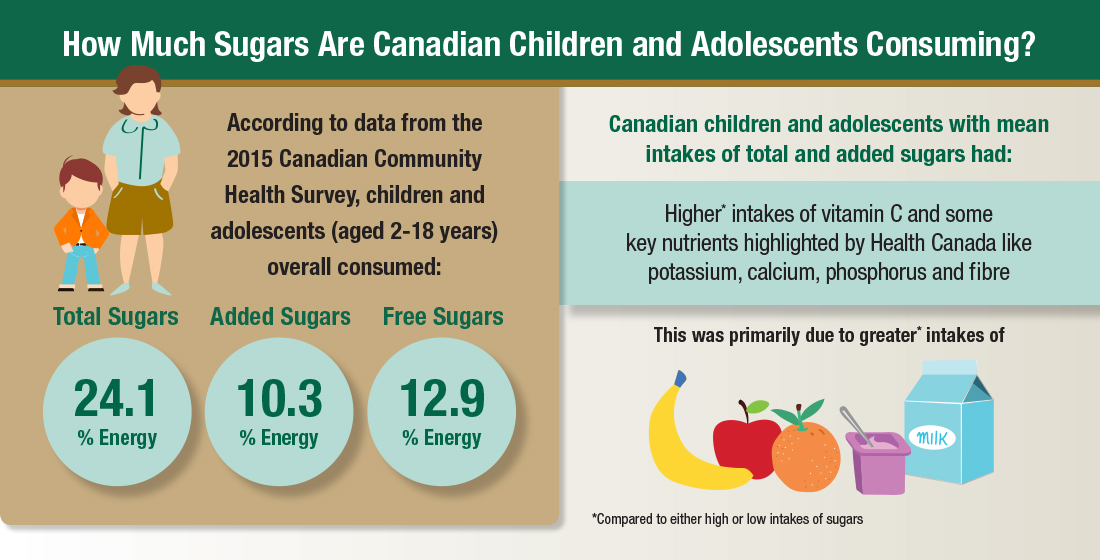Whats New
How Much Sugars Are Canadian Children and Adolescents Consuming?
Dietary recommendations to reduce sugars consumption may influence choices of sugars-containing foods and affect the intake of key micronutrients.
A new study published in Applied Physiology, Nutrition and Metabolism provides the first detailed analyses of macro- and micro-nutrient intakes among Canadian children (2-8 years) and adolescents (9-18 years) stratified by different intakes of total sugars.
Average sugars intakes for the different age categories:
| Total Sugars | Free Sugars | Added Sugars | |
|---|---|---|---|
| Children and Adolescents (2-18 years) | 24.1% Energy | 12.9% Energy | 10.3% Energy |
|
Children (2-8 years) |
25.8% Energy | 12.6% Energy | 9.5% Energy |
|
Young Adolescents (9-13 years) |
23.9% Energy | 13.5% Energy | 11.0% Energy |
|
Older Adolescents (14-18 years) |
22.0% Energy | 12.0% Energy | 10.7% Energy |
Authors of the study from the University of Toronto, St. Michaels Hospital, and the Canadian Sugar Institute, analyzed publicly available data from the Canadian Community Health Survey 2015. Key findings include:
- Canadian children and adolescents’ mean intakes of added and free sugars are above the World Health Organization 10 %E recommendation.
- There was no difference in energy intake across different levels of sugars intakes in all age groups.
- Canadian children and adolescents with lower total sugars intakes generally had higher intakes of protein, fat, sodium, niacin, folate and zinc, and lower intakes of vitamin C compared to those with the highest sugars intakes.
- Children (2-8 years) with mean intakes of total sugars had higher intakes of potassium and riboflavin compared to those with lower sugars intakes. Older adolescents (14-18 years) with mean intakes of total sugars had better intakes of potassium, calcium, and fibre compared to those with lower sugars intakes.
- This could be due to greater intakes of fruits, fruit juice, unsweetened milks, and yogurts.
- Children and adolescents with the highest intakes of total sugars also had the highest intakes of multiple sugars-containing food categories, including fruit, confectionary, milks, cakes/pies/pastries.
- Higher intakes of regular sweetened soft drinks were observed only in older adolescents (14-18 years old), but not in other age groups.
- Older adolescents’ eating patterns were similar to those of adults (Wang et al. 2020).
- Certain nutrient-dense food sources of sugars, like fruit and milks may help increase key nutrients (e.g. potassium, calcium, fibre) in older adolescents with low sugars intakes. However, in those with the highest sugars intakes, nutrient-poor foods may displace nutrient-dense foods.
This analysis was conducted by the researchers and dietitians of the Canadian Sugar Institute in collaboration with researchers from the University of Toronto and St. Michael’s Hospital. Ongoing analyses are assessing diet quality across different levels of sugars intake in relation to dietary recommendations using the same CCHS 2015 database.
- Click to read the full publication
- Click for more information on sugars consumption in Canada
- The results have also been presented at the 2021 Canadian Nutrition Society and Dietitians of Canada national conferences



